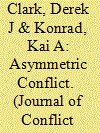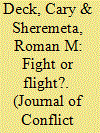| Srl | Item |
| 1 |
ID:
077423


|
|
|
|
|
| Publication |
2007.
|
| Summary/Abstract |
The authors study conflict on multiple fronts. A defending player needs to successfully defend all fronts, and an attacker needs to win at only one. Multiple fronts result in a considerable disadvantage for the defending player, and even if there is a defense advantage at each of them, the payoff of the defending player is zero if the number of fronts is large. With some positive probability, in the equilibrium defending players surrender without expending effort
|
|
|
|
|
|
|
|
|
|
|
|
|
|
|
|
| 2 |
ID:
115730


|
|
|
|
|
| Publication |
2012.
|
| Summary/Abstract |
This article examines theory and behavior in a two-player game of siege, sequential attack and defense. The attacker's objective is to successfully win at least one battle, while the defender's objective is to win every battle. Theoretically, the defender either folds immediately or, if his valuation is sufficiently high and the number of battles is sufficiently small, then he has a constant incentive to fight in each battle. Attackers respond to defense with diminishing assaults over time. Consistent with theoretical predictions, the authors' experimental results indicate that the probability of successful defense increases in the defenders valuation and it decreases in the overall number of battles in the contest. However, the defender engages in the contest significantly more often than predicted and the aggregate expenditures by both parties exceed predicted levels. Moreover, both defenders and attackers actually increase the intensity of the fight as they approach the end of the contest.
|
|
|
|
|
|
|
|
|
|
|
|
|
|
|
|
| 3 |
ID:
075804


|
|
|
|
|
| Publication |
2006.
|
| Summary/Abstract |
This article displays the importance and richness of Hirshleifer's social composition function in public good applications, particularly those in defense economics. This function indicates how individual contributions to the public good combine to determine the overall level of the good that is available for consumption. As such, the concept indicates the aggregation technology of public supply. Applications of this 'aggregator' notion include alliance burden sharing, counter?terrorism policy, and curbing weapon proliferation. For these applications, the article shows how alternate aggregators can have profoundly different collective action and policy implications.
|
|
|
|
|
|
|
|
|
|
|
|
|
|
|
|